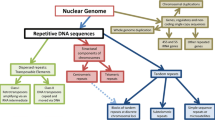Abstract
To understand the architecture of the human genome, we need a complete definition of all the repeat sequence families, as these make up the majority of human DNA. We have isolated a small DNA fragment from human chromosome 21 and have used sequence analysis of this fragment to uncover a new low copy repeat element of approximately 300 bp that we term the Mermaid repeat. This repeat is related to, but is different from, the MER 12 repeat and is interspersed in the genome. Mermaid family members that we have studied are between 81%–87% identical to our preliminary consensus sequence. Therefore, we have added a new member to the large collection of human repetitive elements. In addition, we have mapped a Mermaid repeat to a telomeric position on the long arm of human chromosome 21, at 21q22.3
Similar content being viewed by others
References
Adams MD, Kerlavage AR, Fields C, Venter JC (1993) 3400 expressed sequence tags identify diversity of transcripts from human brain. Nature Genet 4:256–267
Gardiner K, Watkins P, Munke M, Drabkin H, Jones C, Patterson D (1988) Partial physical map of human chromosome 21. Somat Cell Mol Genet 14:623–638
Garret M, McHendry-Rinde B, Spickofsky N, Margolskee RF (1992) Isolation of a clone which induces expression of the gene encoding the human tumor necrosis factor receptor. Gene 111:215–222
Kaplan DJ, Jurka J, Solus JF, Duncan CH (1991) Medium reiteration frequency repetitive sequences in the human genome. Nucleic Acids Res 19:4731–4738
Korn B, Sedlacek Z, Manca A, Kioschis P, Konecki D, Lehrach H, Poustka A (1992) A strategy for the selection of transcribed sequences in the Xq28 region. Hum Mol Genet 1:235–242
Ledbetter SA, Nelson DL, Warren ST, Ledbetter DH (1990) Rapid isolation of DNA probes within specific chromosome regions by interspersed repetitive sequence polymerase chain reaction. Genomics 6:475–481
Littlefield JW (1966) The use of drug-resistant markers to study the hybridization of mouse fibroblasts. Exp Cell Res 41:190–196
Liu P, Legerski R, Siciliano MJ (1989) Isolation of human transcribed sequences from human-rodent somatic cell hybrids. Science 246:813–815
Liu P, Parryman MB, Liao W, Siciliano MJ (1992) Efficiency and limitations of the hn-cDNA library approach for the isolation of human transcribed genes from hybrid cells. Somal Cell Mol Genet 18:7–18
Nelson DL, Ledbetter SA, Corbo L, Victoria MF, Ramirez-Solis R, Webster TD, Ledbetter DH, Caskey CT (1989) Alu polymerase chain reaction: a method for rapid isolation of humanspecific sequences from complex DNA sources. Proc Natl Acad Sci USA 86:6686–6690
Van Keuren ML, Watkins PC, Drabkin HA, Jabs EW, Gusella JF, Patterson D (1986) Regional localization of DNA sequences on chromosome 21 using somatic cell hybrids. Am J Hum Genet 38:793–804
Wang Y, Macke JP, Merbs SL, Zack DJ, Klaunberg B (1992) A locus control region adjacent to the human red and green visual pigment genes. Neuron 9:429–440
Yulug IG, Egan SE, See CG, Fisher EMC (1994) Mapping GRB2, signal transduction gene in the human and the mouse. Genomics 22:313–318
Yulug IG, Katsanis N, Belleroehe J de, Collinge J, Fisher EMC (1995) An improved protocol for the analysis of SOD1 gene mutations, and a new mutation in exon 4. Hum Moi Genet 6:1101–1104
Author information
Authors and Affiliations
Rights and permissions
About this article
Cite this article
Hoyle, J., Yulug, I.G., Johnstone, K. et al. Characterisation of a short interspersed repeat (Mermaid) that has family members on human chromosome 21 and elsewhere in the human genome. Hum Genet 97, 117–120 (1996). https://doi.org/10.1007/BF00218845
Received:
Revised:
Issue Date:
DOI: https://doi.org/10.1007/BF00218845




